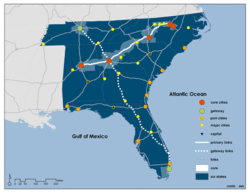Georgia in the rearview mirror?
By Tom Baxter, Georgia Online News Service
For most of this decade, Atlanta has been the nation's fastest growing metropolitan area. But in the latest batch of data released last week by the U.S. Census Bureau, the metro area that had grown fastest in the previous year was Raleigh, N.C., and its suburb, Cary.
Raleigh-Cary grew by 4.3 percent over the year ending last July and, for the first time, it now numbers more than a million people. This could be a mere demographic blip or something we'll look back on a few decades from now as a fateful turning point.
Atlanta and Raleigh lie on the northern and southern ends of what is now being called the Piedmont Atlantic Megaregion, or PAM. More than 34 million people live in the string of cities and suburbs stretching from Raleigh to Charlotte, down through Greenville-Spartanburg and west to Atlanta and Birmingham.
The PAM may be hard to conceptualize, but not if you've ever been slowed by a series of wreck-related traffic jams all the way from Atlanta to Greenville. In 30 years, the empty spaces in that blob of Sunbelt urbanization will have been filled with an additional 84 billion square feet of construction. By 2050, the PAM's population is expected to have grown by another 23 million, or 70 percent.
How to insure that this future population has adequate water, breathable air, the ability to move around and compete in the global economy was the subject of a daylong conference Monday at the Georgia Tech Global Learning Center. It brought together an A-list of planners, business leaders and public officials, including Atlanta Mayor Shirley Franklin and Charlotte, N.C., Mayor Pat McCrory, to talk about the challenges presented by such unprecedented growth.
"Infrastructure is the competitive advantage. The question before us now is what kind of infrastructure do we need to be competitive in the global economy?" said Catherine Ross, director of Tech's Center for Quality Growth and Regional Development.
Queue to the Golden Dome, where this week transportation policy has been addressed by Georgia House and Senate, like two drunks meandering down a mountain road. No one seems to trust anyone else's motives in the debate over the proposed Department of Transportation reorganization, and the question of what any of it means in terms of addressing the real transportation needs of the state remains unanswered.
Getting cities and states across a sprawling region to cooperate with each other isn't going to be a piece of cake, either. The discussion at Monday's conference focused more on getting governments to cooperate with each other, not compete, so no one ever asked what the PAM's economic and population center was likely to be in 2050. But as an antidote to complacent thinking, it's a question worth considering.
More than most cities, Atlanta became what it is because of its crossroads position, for railroads, interstates and, most spectacularly, airline traffic. Its metro area gobbled new space at an historic rate, but getting around that sprawling mass becomes ever more difficult.
By contrast, you can get a train from Raleigh to Charlotte for $25. A decade or so from now, that will mean a lot more than it does today. Charlotte has a snazzy new light rail system. Unlike Georgia, North Carolina has positioned itself to pick up a significant chunk of the $8 billion set aside in the stimulus package for development of rapid-rail corridors, linking Raleigh with Richmond, Va., and the Northeast Megaregion.
The string of North Carolina cities that stretch from Raleigh to Charlotte have seen their share of busts, from textiles to tobacco, and from banking to high tech, but they have been well-served by their state's investments in education and transportation, and they have more time and room to plan wisely for the next 50 years than the Atlanta Metroblob.
In short, Raleigh, or maybe Charlotte, look to be another airport expansion or so away from becoming the PAM's crossroads city, while Atlanta slowly morphs into the megaregion's Macon.
It may not be a bad thing, in the long run, if the ATL isn't in the middle of the PAM. Metro Atlanta has enough to handle coping with its growing water problems and its failure over the past few years to move its transportation system into a new era. But for the Next Great City, the Olympic City, the International City, it's going to take some getting used to.
(Image: Photo of PAM courtesy of Georgia Tech)
Tom Baxter is editor of the Southern Political Report and senior vice president of its parent company, InsiderAdvantage, a media and polling firm. He was the chief political correspondent at the Atlanta Journal-Constitution for 20 years.

